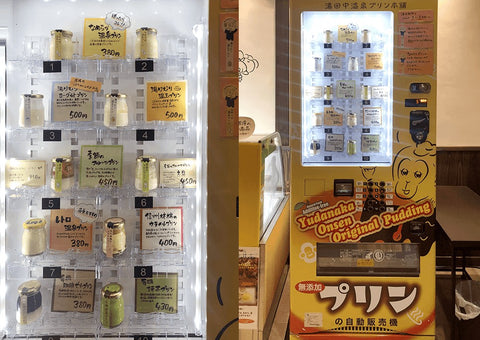Hojicha Pudding
Ingredients:
- Gelatin 2 tsp
- Water 2 tbsp
- Almond Milk 1½ cup
- Hojicha Loose Leaf 4 tbsp
- Brown Sugar 2 ½ tbsp
- Heavy Cream ¾ cup
For toppings:
- Heavy Cream ½ cup
- Dark chocolate (optional)
Directions:
- Dissolve the gelatin in the water and set it aside.
- In a small pan, heat the almond milk and hojicha loose leaf. Simmer on medium heat for 3 min.
- Rest for 15 min. Strain the simmered tea through a strainer.
- Bring it back to heat. Dissolve brown sugar and add gelatin mixture. Mix until all dissolves.
- Add heavy cream and mix well.
- Pour the mixture into cups and chill them for 5 hours.
- Decorate with whipped cream and shaved chocolate!
The Evolution of Pudding in Japan: A Sweet Journey
Pudding, or プリン (purin) as it's affectionately known in Japan, has a special place in the hearts of many Japanese dessert lovers. This simple yet delightful treat has evolved significantly since its introduction, blending traditional flavors with modern twists.
Origins and Western Influence
Pudding made its way to Japan during the Meiji era (1868-1912), a period marked by rapid Westernization and the introduction of many Western foods. Originally, Japanese pudding was similar to the custard pudding familiar in the West, known for its creamy texture and caramel sauce. This dessert was a representation of Western luxury and exoticism, initially enjoyed by the upper class and gradually becoming popular across all levels of society.
Local Ingredients and Flavors
As pudding grew in popularity, local adaptations began to appear. Japanese chefs and home cooks started incorporating local ingredients such as matcha (green tea powder), yuzu (a citrus fruit), and kurogoma (black sesame), which not only added a touch of Japanese flavor but also transformed the dessert into something uniquely Japanese.
Modern Innovations
In recent years, pudding in Japan has seen innovative variations, particularly in its texture and form. The "mizu shingen mochi" or water cake, a clear and jelly-like dessert, is a perfect example of this innovation. There's also the incredibly silky "purin" that nearly melts in your mouth, showing the Japanese mastery of delicate textures.
Cultural Significance
Today, pudding is not just a treat; it's a part of the cultural fabric of Japan, often found in convenience stores as a quick snack, served in high-end restaurants as a gourmet dessert, or made at home for a family celebration. It's a testament to Japan's ability to embrace and adapt foreign influences, creating something new and exciting while still honoring traditional tastes and techniques.
Japanese Pudding in Conbini コンビニ
Pudding is an exceptionally popular dessert in Japanese convenience stores, known locally as "conbini." Its widespread popularity stems from several key factors that cater to the tastes and needs of a broad demographic, from busy office workers to students and tourists.

Japanese conbini pudding isn't just a dessert; it's a cultural staple that can be found in virtually every convenience store across the country, from the bustling streets of Tokyo to the quieter rural areas. These stores, including major chains like 7-Eleven, FamilyMart, and Lawson, typically offer an impressive array of pudding options. The selection goes beyond the classic custard pudding with caramel sauce to include flavors like matcha, mango, and even seasonal specialties like cherry blossom in spring or pumpkin in autumn. (Read what I wrote about Japanese Conbini Coffee War here)
Japanese Pudding in Jihanki (vending machine) 自販機
And you guessed it, puddings are also available in Japanese vending machines aka Jihanki! An example; in the charming setting of Yudanaka Onsen, a renowned hot spring destination in Japan, the Yudanaka Onsen Purin Honpo (湯田中温泉プリン本舗) stands out not just for its relaxing baths but also for its unique offering: a pudding vending machine, or "pudding jihanki." This delightful addition to the area offers visitors a sweet taste of local culture, literally and figuratively. (Read what I wrote about Japanese Jihanki here)

Japanese Pudding in Anime アニメ
In "Dragon Ball Z: Battle of Gods," (ドラゴンボールZ) the character Beerus the Destroyer becomes enraged over not getting to eat pudding at Bulma’s birthday party. This incident actually triggers the main conflict of the movie. Although it's a comedic and exaggerated reaction, it underscores pudding's role as a catalyst in the storyline, albeit in an unexpected and larger-than-life way.
Japanese Pudding in Pokemon ポケモン

Pic: Creative Common License
Pokemon's popular character Jigglypuff, known as Purin (プリン) in Japanese, is indeed related to the concept of pudding, but the connection is more about its characteristics than the dessert itself. The name "Purin" in Japanese doesn't directly translate to the English word "pudding" as in the dessert, but rather it's a play on words that matches Jigglypuff’s physical traits and behavior.
The name "Purin" evokes the image of something soft, squishy, and jiggly, much like the dessert pudding, particularly the custard-like variety that's common in Japan. This is reflective of Jigglypuff's round, balloon-like body which is soft and bouncy.
Sign up to free Green Tea Club to keep in touch with the latest Japanese Trend
Buy Japanese Hojicha
Get Free Bonus Books

Sign up for free to the Green Tea Club to get advice and exclusive articles about how to choose Japanese Tea, and tips, tricks, and recipes for enjoying Japanese tea.
About the author
Kei Nishida
Author, CEO Dream of Japan
Certification: PMP, BS in Computer Science
Education: Western Washington University
Kei Nishida is a Japanese green tea enthusiast, a writer, and the founder and CEO of Japanese Green Tea Co., a Dream of Japan Company. His passion for introducing America to the tea of his homeland was the catalyst for creating the only company that brings high-quality tea from Arahataen Green Tea Farms to the rest of the world. Learn more about Kei


























